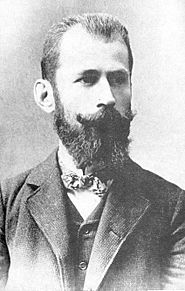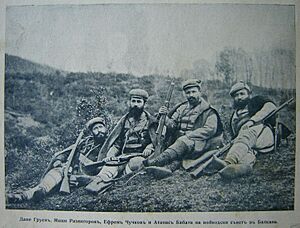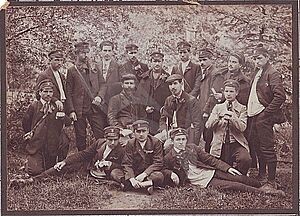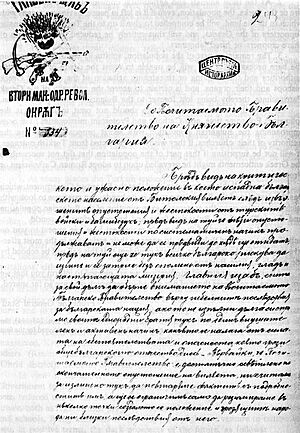Dame Gruev facts for kids
Quick facts for kids
Dame Gruev
|
|
|---|---|
 |
|
| Born | January 17, 1871 |
| Died | December 23, 1906 (aged 35) |
| Nationality | Ottoman/Bulgarian |
| Organization | Bulgarian Macedonian-Adrianople Revolutionary Committees (later SMARO, IMARO, IMRO) |
Damyan Yovanov Gruev (Bulgarian: Дамян Йованов Груев, Macedonian: Дамјан Јованов Груев; January 19, 1871 – December 23, 1906) was a Bulgarian teacher and a leader in a movement for freedom in the Ottoman Empire regions of Macedonia and Thrace. He was one of the six people who started the Internal Macedonian Revolutionary Organization (IMRO).
Contents
About Dame Gruev
Early Life and Education
Dame Gruev was born in 1871 in the village of Smilevo, which was then part of the Ottoman Empire (today in North Macedonia). He went to school in Smilevo and later in Thessaloniki. He was part of a group of students who left the school after a protest.
In 1888, Gruev and 18 other students went to study in Belgrade, the capital of Serbia. Later, he moved to Bulgaria and studied at Sofia University. While there, he joined a group called "Druzhba." This group wanted to achieve self-rule for Macedonia, as mentioned in an important agreement called "Article 23" of the Treaty of Berlin (1878). In 1891, Gruev was briefly suspected in a serious event, but it was found to be untrue.
After leaving the university, Gruev returned to the Ottoman Macedonia region. He decided to become a Bulgarian school teacher. This helped him to secretly work on his plans for a new revolutionary organization. He taught in his home village of Smilevo and then in Prilep.
Later, Gruev moved to Thessaloniki. Here, he helped create the BMARC, which stood for the Bulgarian Macedonian-Adrianople Revolutionary Committees. With friends like Hristo Tatarchev and Petar Pop Arsov, he wrote the rules for this secret group. The goal was to have local revolutionary committees in Macedonia and the Adrianople (Edirne) region.
Building the Organization (1894-1900)
In 1894, Dame Gruev set up the first local committee in Negotino. Soon after, he helped create a district committee in Štip. He also visited other towns like Resen, Ohrid, and Struga. He found that many people supported his ideas for the organization.
From 1895 to 1897, Gruev worked in Thessaloniki as a school inspector. During this time, he became the main leader of the Central Revolutionary Committee. He helped create secret papers, codes, and ways to communicate between different local committees. He also sent someone to Sofia to buy supplies for the organization. Gruev traveled a lot, setting up committees in many villages and cities.
In 1897, Gruev also helped start the Society against Serbs. To avoid drawing attention from the Ottoman authorities, the organization decided to remove Gruev from his position in 1898. He then moved to Bitola and started a revolutionary newspaper there.
In Bitola, Gruev organized a system to collect money from Sunday schools. This money was used to buy supplies. He was also a teacher in Bitola and managed the revolutionary movement in the Bitola area. The Ottoman authorities noticed the increase in armed groups (called chetas) in the mountains. They suspected Gruev was behind this. On August 6, 1900, he was arrested and put in Bitola jail. Even from jail, he managed to stay in touch with the committees and guide the movement using secret messages. He remained in jail until May 1902.
The Uprising
In May 1902, Gruev was sent to a prison called Podrum Kale in Anatolia. There, he met other leaders who had also been exiled. They stayed there for ten months. Even though he was far away, Gruev kept up with what was happening in Macedonia and Thrace through secret letters.
In 1903, he was released from prison as part of a general pardon. Gruev quickly went to Thessaloniki. He found that the Central Committee had already decided to start a big uprising that year. Gruev wasn't sure if they were ready, but he agreed with the committee's decision.
He then went to Smilevo for a special meeting called the insurrectionary Congress. The goal was to pick a date for the uprising and plan how to fight. Gruev was chosen to lead this meeting. The Congress decided the uprising would start on August 2, 1903. Gruev, Boris Sarafov, and Anastas Lozanchev were chosen to lead the forces in the Bitola region.
Gruev saw the Turkish soldiers leave his home village of Smilevo. During the uprising, he fought in many battles against the Ottoman Army. However, more Ottoman troops arrived, and the uprising was crushed within six weeks. Gruev then traveled around, collecting weapons and preparing for a future uprising.
After the Uprising
In 1904, Dame Gruev led a meeting in Prilep for the Bitola Revolutionary District of IMRO. Later that year, he was captured by a Serb leader named Micko Krstić. But he was freed with the help of Gligor Sokolović after talks with Pere Toshev.
In 1905, Gruev led the first big meeting of the organization after the uprising, known as the Rila Congress. Here, Dame Gruev was chosen as a member of the Central Committee and became its leader until his death. He was seen as the only one who could manage Yane Sandanski's desire for leadership. However, the Rila Congress did not solve all the disagreements within the organization.
At the end of 1906, Gruev was traveling with his group from Ottoman Macedonia to Sofia for another special meeting. On December 23, 1906, Dame Gruev and his group were found by Turkish authorities near the village of Rusinovo. In the battle that followed, Dame Gruev was killed.
Legacy
A high school in Sofia, Bulgaria, and Gruev Cove on Greenwich Island in Antarctica are named after Dame Gruev.
See also
- IMRO
- History of North Macedonia
- History of Bulgaria (1878–1946)
- Gotse Delchev
- Battle of Smilevo
Images for kids







